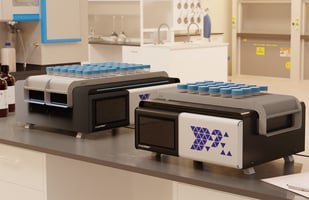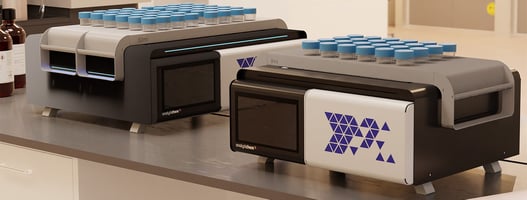Exciting News! Introducing the SNRG Block™ System by AnalytiChem Sample preparation is one of the...
Digestion Block – An Analytical Lab Sample Preparation Workhorse
At first glance, the digestion block may appear to be a basic, maybe even outdated, tool. But do not be fooled by its external simplicity. With established methodology for many applications and reliable performance, the digestion block can truly be called a sample preparation workhorse.
This type of digestion system is known by many names: thermal digestion system, block digester, hot block system, and more. Regardless of the system name, the function is the same: deliver a controlled transfer of heat to open sample vessels to drive sample digestion.
To perform this function, digestion block systems include the following:
- A Heating Element that generates the heat required for sample digestion. It is usually made with a resistive material—such as Nichrome wire or ceramic materials with embedded heating coils—that can reach elevated temperatures quickly and maintain them steadily.
- A Block, constructed from thermally conductive materials like aluminum or graphite, serves as a heat reservoir to provide a stable and even heat distribution across all the wells.
- Multiple Temperature Sensors, such as thermocouples or resistance temperature detectors (RTDs), are embedded in various locations and continuously monitor the temperature across the digestion block.
- A Temperature Control System that maintains the desired temperature profile during the digestion process by receiving input from the temperature sensors and adjusting power to the heating element.
- A Programmable Controller which can be as simple as a temperature set point with a timer or as complex as a touchscreen that enables multi-stage method development and control.

The Advantages and Challenges of Digestion Blocks
Digestion blocks deliver several advantages over other sample digestion options:
- Flexibility: Customizable, multi-step temperature/time profiles allow researchers to tailor the digestion process to meet specific experimental requirements, including adding reagents throughout the digestion process.
- Temperature Uniformity: Precise temperature control makes the digestion process highly reproducible, leading to consistent and reliable results.
- Safety: To prevent potential hazards, today’s digestion heating blocks often come with built-in timers, alarms, automatic shut-off mechanisms, and user-defined safety limits. Some even provide remote monitoring. These features help prevent overheating, reduce the risk of sample loss or damage, and improve laboratory safety.
- Higher Throughput: Digestion blocks enable the simultaneous digestion of multiple samples, significantly reducing overall analysis time and enhancing laboratory efficiency.
- Versatility: Digestion block designs vary in configurations and well sizes to accommodate varied sizes of digestion tubes, which can be made of materials like borosilicate glass, quartz, or high-quality plastics such as polypropylene and Teflon. This versatility allows researchers to process a variety of sample types, volumes, and reagents with a single system.
Despite the many advantages, there are some challenges for digestion blocks. One major drawback is that the system operates with open vessels. This means that procedures are limited by the ambient pressure boiling points of the reagents in use, resulting in longer digestion times and meaning some digestions cannot be performed. Additionally, open vessels mean that contamination from the surroundings is possible. Finally, certain elements, such as Hg, As, and Se, can volatilize and escape from the sample matrix due to elevated temperatures in the digestion process.
Common Uses for Digestion Blocks
Digestion blocks can handle many types of samples, including solid materials, liquids, and even complex matrices. Applications include the determination of heavy metals, trace element analysis in biological specimens, analysis of nutrients and contaminants in food and beverages, and many other research and quality control procedures. Digestion blocks are also well-suited for analyzing environmental samples such as soil and water for monitoring or regulatory purposes. As a result, government bodies, such as the US EPA, have published standard methods for environmental testing that include digestion blocks as the preferred sample preparation technique. Some examples of these methods are outlined below.
- EPA Method 200.2 outlines sample preparation procedures for the determination of total recoverable analytes in groundwaters, surface waters, drinking waters, and wastewaters. It is a common method to quantify the concentration of various metals and trace elements for routine water quality monitoring, compliance with environmental regulations, and assessments of drinking water safety.
- EPA Method 3010A outlines an acid digestion procedure for aqueous samples and other sample types, including wastes that contain suspended solids, to prepare for analysis by flame atomic absorption spectroscopy (FLAA) or inductively coupled argon plasma spectroscopy (ICP). This method is used to determine total metals.
- EPA Method 3050B (a modification of EPA 3050) provides two separate digestion procedures: one for the preparation of sediments, sludges, and soil samples for analysis by FLAA or ICP-AES (plasma atomic emission spectrometry), and one for analysis of these samples by GFAA (graphite furnace AA) or ICP-MS (mass spectrometry). It is designed to be more efficient and applicable to a broader range of sample matrices, including those with higher organic content.
Digestion blocks are also suitable for EPA mercury prep methods, like 245.1, 245.6, 245.2, 245.7, 7470A, and 7471B.
Conclusion
There are a range of digestion blocks available in the market, each with slightly different features. To unlock the most benefits, it is essential to select the right digestion block for your application. The right digestion block can be an indispensable tool in your analytical laboratories, providing a reliable, consistent means of sample preparation for a wide range of chemical analyses.
Read our blog about our new SNRG Digestion Block:






.png?width=50&name=MicrosoftTeams-image%20(1).png)